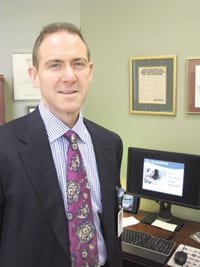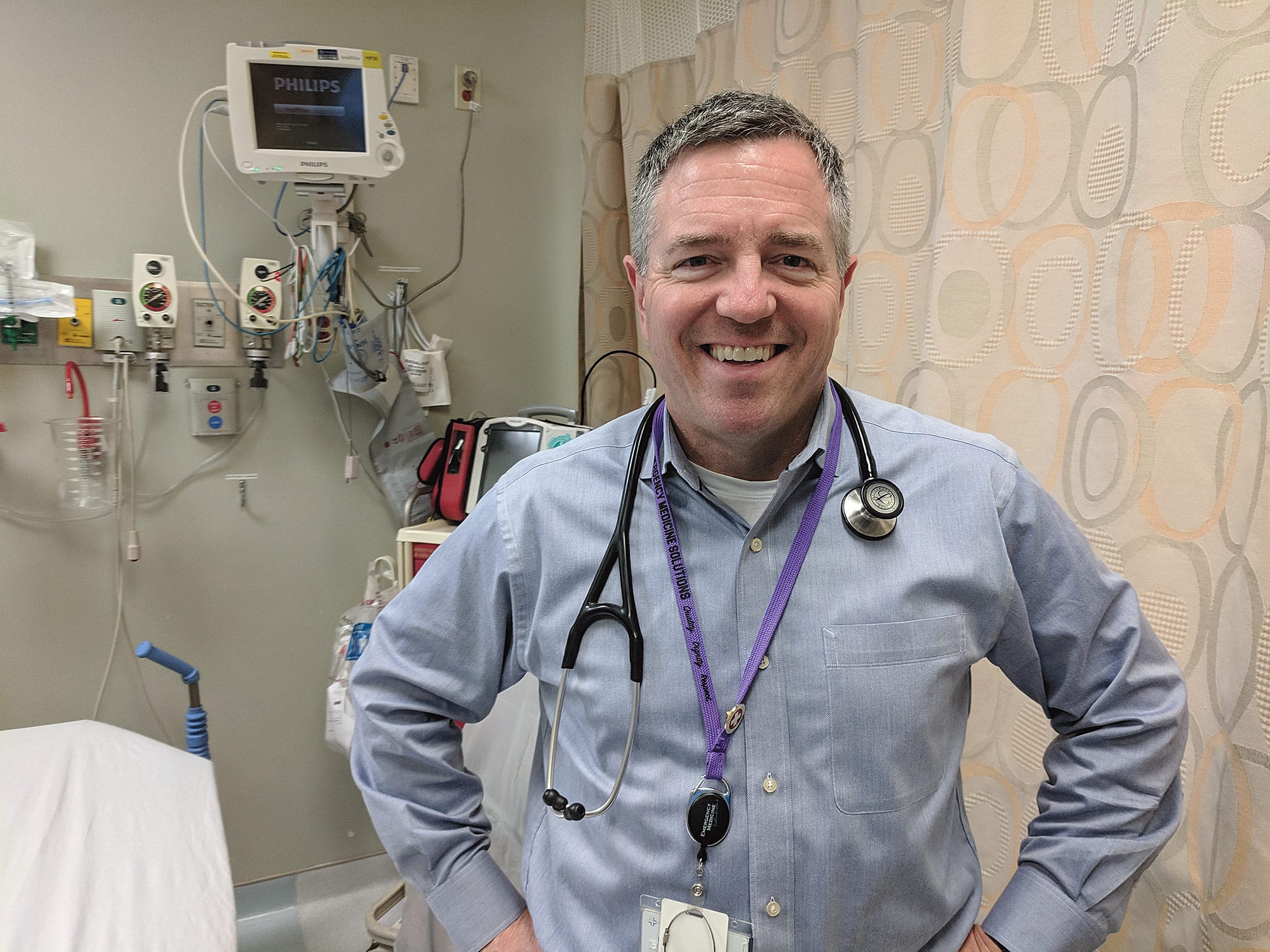His Energy Is Infectious – Baystate’s Chair of Medicine Wants to Be an Instrument of Change
Dr. Andrew Artenstein likes to say that he’s from the “vaccine world.”
He summoned that phrase to describe both his family history — his father was an infectious-disease specialist and worked to develop the first safe and effective vaccines against meningococcal meningitis — and a career’s work that includes titles ranging from “attending physician, Department of Medicine, Infectious Diseases Service, Walter Reed Army Medical Center” to “founding director of the Center for Biodefense and Emerging Pathogens.”
It also sums up, in a way, the two books he’s authored — Vaccines: A Biography, published in 2010, and the recently released In the Blink of an Eye: The Deadly Story of Epidemic Meningitis — and articles and book chapters he’s written with titles like “Biodefense: Medicine in the Time of Bioterrorism.”
But he also uses that phrase to characterize his overall approach to medicine and the operating philosophy he takes with him to work each day in the role he accepted six months ago: chair of the Department of Medicine at Baystate Medical Center.
“In the vaccine world, your whole life, your primary mission, is preventing a problem,” he told HCN. “And that’s always the way I’ve approached things. Prevention is less sexy, but it has a lot more cachet, and it’s a lot more sustainable.”
Artenstein said he came to Baystate because it is the proverbial right place (and in the right state) at the right time. By that he meant that Massachusetts, on the whole, is breaking new ground in the evolution of healthcare, and Baystate has emerged as one of the leaders in a task he described as “bridging two worlds” — the old world and the new world in health care — and eventually transitioning to the latter. It has also developed a reputation as an institution that not only embraces change, but creates pathways for it.
“I like being chair of a department that affords you the opportunity to initiate change, to be an agent of change, and to nurture the careers of people who could also be agents of change,” he explained. “The part of the job that keeps it fresh and that I love is that you can try to solve problems — and there’s a lot of problems everywhere you go with what we do for a living.
“I came here because Baystate is on the cutting edge of transforming health care to a different model, in a state that’s already at the cutting edge,” he continued. “And to me, it’s very exciting at this stage of my career to be in a position to elicit change.”
For this issue, HCN talked at length with Artenstein about that process of initiating change, and how his new position at Baystate will enable him to take that philosophy of prevention that defines vaccinology to all aspects of healthcare.
An Intriguing Bio
When asked what he’s learned, or determined, in his first six months at Baystate, Artenstein started with some humor.
“I’ve learned that I can get by on less sleep than I thought,” he quipped, before turning much more serious.
“I’ve also learned that there are a lot of complex issues in healthcare today — actually, I already knew that, but this has confirmed it,” he went on. “To try to make these changes and do better in the way we deliver care is a very complex undertaking. If it were easy, it would have been done. It involves a lot of moving parts.”
It was a willingness to confront these issues — and in a state and system that are at the forefront of change in healthcare — that prompted Artenstein to leave both his role as physician in chief of the Department of Medicine at Memorial Hospital of Rhode Island in Pawtucket and his position at the Center for Biodefense and Emerging Pathogens.
Those were two of the more recent career stops, most of them involving infectious diseases, that has taken Artenstein from work with the federal government and an eight-year stint at Walter Reed in Washington, D.C., to private practice, to a lengthy stay in medical academia at the Warren Alpert Medical School at Brown University.
He said he got what he would consider a late start toward a career in medicine, but that, in retrospect, he thought he was destined for work with infectious diseases, in large part due to the inspiration generated by his father.
“Once I made the decision to go into medicine, I always knew I’d be doing infectious-disease and vaccine work, because that’s what I knew and grew up loving and appreciating,” he explained. “Although I love every part of medicine — I enjoy taking care of patients and all the different problems and teamwork that ensues from the hospital — I grew up in an atmosphere where I got to see the fruits of their labor when it comes to developing vaccines, staving off epidemics, halting outbreaks of disease, or preventing outbreaks of disease.
“To me, it represents maybe the biggest bang for the buck in medicine,” he continued, “because you are able to help a lot of people, and in a very broad way; you help individual patients and society as a whole. There’s a big public-health component, which I like, there’s a big personal side of it, and there’s great science behind it.”
He gained a further appreciation for this specialty during his stint at Walter Reed, which took him overseas while conducting research for the Army. “It was the best of all worlds, really,” he said. “I got to experience global health and global infectious diseases; I came to appreciate the impact of these things on people all over the world.”
As he mentioned, the opportunity to come to Baystate represented a chance to manage a much larger department of medicine and also be involved in cutting-edge work with many of those issues he described.
He said there are many duties, or rungs, involved with this position — everything from training residents to stewarding the resources of Baystate — and that this broad job description appeals to him.
“There are the high-level strategic initiatives, which involve thinking about how to support the practice of medicine in the community, how to provide care to the community, and also how to reach new communities peripheral to our own that also need the care we can provide,” he explained. “So there’s that strategic view of how to do things — what type of care, how to provide the care, and in what settings.
“But there’s also an operational piece that centers on how you actually get it done and implement these things,” he continued. “How do you do that and also maintain a strong medical education component, because it’s key that we continue to train the doctors of tomorrow.
“We’re also an academic department,” he went on, “meaning that there are people asking scholarly questions and asking for answers through research. We do research on how best to deliver healthcare, how to compare doing it one way with doing it another way. We’re looking for evidence for what we do to make sure we’re practicing medicine in the most high-value, cost-conscious way.”
Taking His Best Shot
Artenstein told HCN that he is involved with a number of initiatives at present, all designed to improve overall service to Baystate’s many constituencies — and to strengthen that bridge between the old and new worlds of healthcare.
One of them involves development of strategic initiatives to ensure region-wide accessibility to the many sub-specialties represented at Baystate and its Department of Medicine — from pulmonary care to gastroenterology; neurology to infectious diseases.
“We want to ensure that doctors as far away as Ware or Greenfield or into the Berkshires can access our specialty help if they need those services,” he explained. “And this will require some innovation because there simply aren’t enough people to get in their cars and drive everywhere to provide care; we’re going to have to figure out strategic ways to do that and work with the primary-care doctors to make sure we can support them and be available for expert consultation.”
Part of the solution will involve strategically placing physicians in certain areas, he went on, adding that more imaginative steps, or relationships — yet to be determined — will also be needed.
Another initiative, one that he’s spending a good deal of time on, involves improving the communication between doctors in the hospital and doctors in the community when it comes to patient care, a relatively recent issue within the healthcare industry given the rise of the hospitalist model of providing care.
“There was a time when we didn’t have to do this because, 20 years ago, the doctor in the community was also the doctor in the hospital,” he noted. “That’s rarely the case anymore, and that’s a national trend, not something specific to Massachusetts or Baystate. Times have changed the way people practice medicine, and it’s very uncommon for community or internal-medicine doctors to round in the hospital and check in on their patients.
“There has to be two-way communication because we’re caring for the same people,” he continued. “I’m looking at making sure there’s this seamless care of the patient across every transition.”
And there are many of these transitions, he went on, noting that the patient will often go from the home to the hospital to an intermediate stop such as a rehab clinic or assisted-living facility to continue to convalese. “There are all kinds of steps before the patient is back in the community — how do you make that seamless and continuous? We’re working hard to see that there’s a seamless pathway.”
Still another initiative in progress involves something Artenstein calls “age transition.”
Elaborating, he said that many patients who suffer from illnesses and disabilities that continue from childhood into adulthood, such as diabetes, will be treated by different doctors at different ages, when there is ample evidence to support the theory that continuity of care, provided by the same physician, makes more sense.
“When people turn 18, they often get a new doctor,” he explained, adding that he recently recruited someone who is both an adult and pediatric endocrinologist, and will look to make more such hires in the future. “My goal is to start a practice of age transition so we can work across that spectrum.”
Artenstein said the opportunity to work on such projects was the primary motivation for his decision to come to Baystate and reaffirm his desire to effectuate change in how healthcare is provided.
“There’s a great willingness from the highest levels of Baystate to transform the way we do things,” he noted. “And it’s exciting to work in such an environment.”
Down to a Science
Beyond the books, articles, and job titles on his résumé, there is one more large clue that Artenstein lives in the ‘world of vaccines.’
This would be the many images of Louis Pasteur that adorn the walls of his office and the small conference adjacent to it.
“He’s one of my heroes, obviously,” Artenstein told HCN, adding that, since Pasteur’s groundbreaking work a century and a half ago, the work within vaccinology has been best described as prevention.
And that’s an attitude, or philosophy, that he’s bringing to every aspect of a job with a number of moving parts. v



Comments are closed.